
OceansArt.US
|
Named for Lt. David Bartholomew of the British Navy, this small island is located just east of Santiago Island. Desolate Isla Bartolomé is one of the most visited and photographed islands in the Galápagos. Bartolomé is an extinct volcano and has a variety of variably colored volcanic formations, including a tuff cone known as Pinnacle Rock. This large black partially eroded cone was created when lava reached the sea. Contact with seawater resulted in a phreatic explosion. The exploded molten fragments fused together forming a welded tuff. Isla Bartolomé is inhabited by Galápagos Penguins, sea lions, nesting marine turtles, white-tipped reef sharks and a variety of birds.
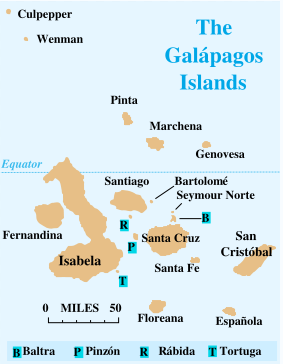
The Galápagos Islands (Official name: Archipiélago de Colón; other Spanish names: Islas de Colónumio or Islas Galápagos, from galápago, "saddle"—after the shells of saddlebacked Galápagos tortoises) are an archipelago of volcanic islands distributed around the equator, 965 kilometres (about 600 miles) west of continental Ecuador in the Pacific Ocean (1° S 91° W). The group consists of 13 main islands, 6 smaller islands, and 107 rocks and islets. The islands are located at a geological hot spot, a place where the earth's crust is being melted from below by a mantle plume, creating volcanos. The oldest island is thought to have formed between 5 and 10 million years ago. The youngest islands, Isabela and Fernandina, are still being formed, with the most recent volcanic eruption in 2005. It is one of the few places in the world without an indigenous population. The Galápagos archipelago is a province of Ecuador, a country in northwestern South America, and the islands are all part of Ecuador's national park system. They are famed for their vast number of endemic species and the studies by Charles Darwin during the voyage of the Beagle that contributed to the inception of Darwin's theory of evolution by natural selection.
(Adapted from: Galapagos (2008): Wikipedia, The Free Encyclopedia)
See all the free photos, including other photos of Ecuador by going to the Photo Catalog. Click on any picture for a FREE larger version. Read the licensing rules (REVISED) for your needs. There are hundreds of high quality free photos: use the Google/site search engine. See our digital photography tips : DOs and Don'ts; Choosing a Camera and Accessories , Downloading Photos, and Editing Photos. Visit TechnologySite.org for free photos and lists of inventions and technology and learn Climate Change Facts to see for yourself if your area is at risk from global warming or global cooling.
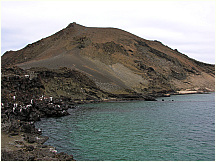 bartholomewisland01.jpg Photo of swimming beach and cove on Bartholomew Island (Isla Bartolomé), Galapagos Islands, Ecuador |
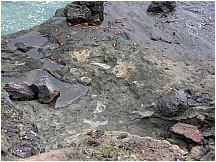 bartholomewisland06.jpg Sally Lightfoot Crabs in the sun on the lava rocks. These crabs can jump from rock to rock and move rapidly. |
|
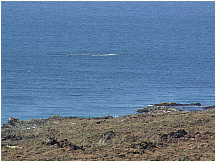 bartholomewisland33.jpg Tuna school working on bait fish off Bartholomew Island (Isla Bartolomé), Galapagos Islands, Ecuador |
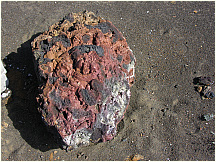 bartholomewisland34.jpg Large rock, showing cinder and solid rock all fused together on Bartholomew Island (Isla Bartolomé), Galapagos Islands, Ecuador |
|
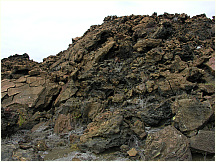 bartholomewisland02.jpg Sharp, uneroded lava rocks and light weight cinders in piles on Bartholomew Island (Isla Bartolomé), Galapagos Islands, Ecuador |
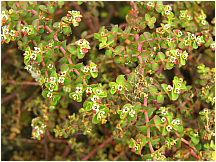 bartholomewisland03.jpg A pioneering plant, with spider webs growing in the lava rock on Bartholomew Island (Isla Bartolomé), Galapagos Islands, Ecuador |
|
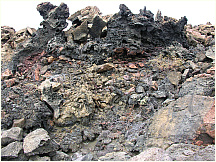 bartholomewisland04.jpg Sharp, uneroded lava rocks and light weight cinders in piles on Bartholomew Island (Isla Bartolomé), Galapagos Islands, Ecuador |
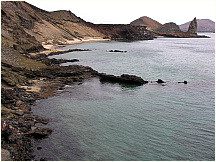 bartholomewisland05.jpg Rugged, rocky coast, transitioning to a sandy swimming beach, and the Pinnacle Rock on Bartholomew Island (Isla Bartolomé), Galapagos Islands, Ecuador |
|
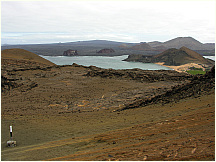 bartholomewisland16.jpg Desolate desrt-like conditions on Bartholomew Island (Isla Bartolomé), Galapagos Islands, Ecuador |
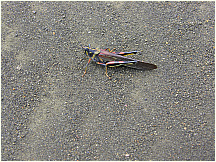 bartholomewisland17.jpg Grasshopper struggling to make a living on virtually plantless Bartholomew Island (Isla Bartolomé), Galapagos Islands, Ecuador |
|
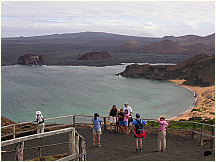 bartholomewisland18.jpg Tourists taking photos on Bartholomew Island (Isla Bartolomé), Galapagos Islands, Ecuador |
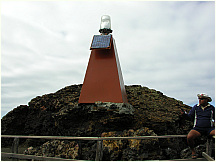 bartholomewisland19.jpg A photovoltaic panel powers this navigation light on the top of Bartholomew Island (Isla Bartolomé), Galapagos Islands, Ecuador |
|
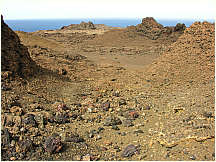 bartholomewisland27.jpg Sharp, uneroded lava rocks and light weight cinders give the appearance of a moonscape on Bartholomew Island (Isla Bartolomé), Galapagos Islands, Ecuador |
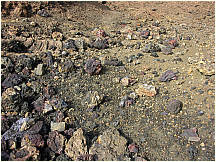 bartholomewisland28.jpg Sharp, uneroded lava rocks and light weight cinders give the appearance of a moonscape on Bartholomew Island (Isla Bartolomé), Galapagos Islands, Ecuador |
|
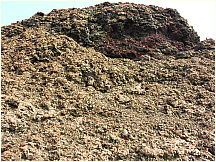 bartholomewisland29.jpg Sharp, uneroded lava rocks and light weight cinders give the appearance of a moonscape on Bartholomew Island (Isla Bartolomé), Galapagos Islands, Ecuador |
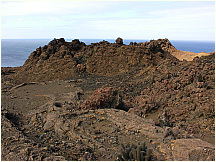 bartholomewisland30.jpg Sharp, uneroded lava rocks and light weight cinders give the appearance of a moonscape on Bartholomew Island (Isla Bartolomé), Galapagos Islands, Ecuador |
|
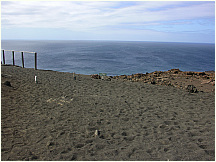 bartholomewisland31.jpg A STOP sign, meant to be a viwing point for tourists, also gives a fair warning, on Bartholomew Island (Isla Bartolomé), Galapagos Islands, Ecuador |
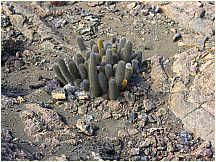 bartholomewisland32.jpg A pioneering cactus on desolate Bartholomew Island (Isla Bartolomé), Galapagos Islands, Ecuador |
|
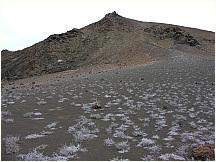 bartholomewisland07.jpg A few pioneering plants amidst the volcanic ash on Bartholomew Island (Isla Bartolomé), Galapagos Islands, Ecuador |
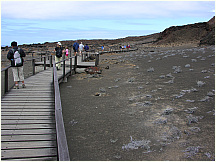 bartholomewisland08.jpg A boardwalk lifts tourists over a few pioneering plants and volcanic ash on Bartholomew Island (Isla Bartolomé), Galapagos Islands, Ecuador |
|
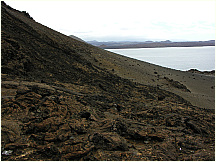 bartholomewisland09.jpg Sharp, uneroded lava rocks and light weight cinders make most of Bartholomew Island (Isla Bartolomé), Galapagos Islands, Ecuador look as the surface of the moon |
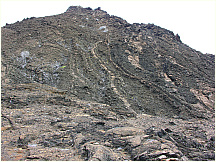 bartholomewisland10.jpg Trails from an old lava flow mark their path on a hillside on Bartholomew Island (Isla Bartolomé), Galapagos Islands, Ecuador |
|
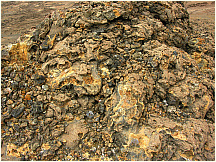 bartholomewisland11.jpg Sharp, uneroded lava rocks and light weight cinders in piles on Bartholomew Island (Isla Bartolomé), Galapagos Islands, Ecuador |
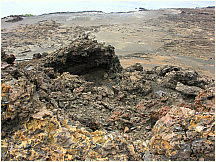 bartholomewisland12.jpg Sharp, uneroded lava rocks and light weight cinders in piles on barren Bartholomew Island (Isla Bartolomé), Galapagos Islands, Ecuador |
|
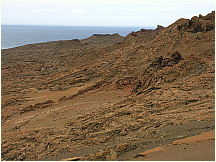 bartholomewisland13.jpg Sharp, uneroded lava rocks and light weight cinders litter the landscape on Bartholomew Island (Isla Bartolomé), Galapagos Islands, Ecuador |
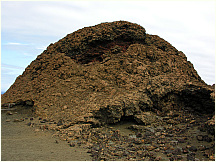 bartholomewisland14.jpg A volcanic cone on Bartholomew Island (Isla Bartolomé), Galapagos Islands, Ecuador |
|
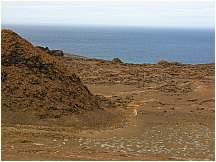 bartholomewisland15.jpg Lava rocks and ash reach in all directions to the sea on Bartholomew Island (Isla Bartolomé), Galapagos Islands, Ecuador |
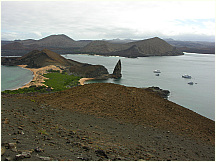 bartholomewisland20.jpg Lava rocks and ash reach to the sea and Pinnacle Rock, with tourist boats at anchor on Bartholomew Island (Isla Bartolomé), Galapagos Islands, Ecuador |
|
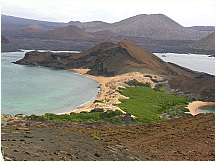 bartholomewisland21.jpg Lava rocks and ash reach to the sea opposite Pinncle Rock on Bartholomew Island (Isla Bartolomé), Galapagos Islands, Ecuador |
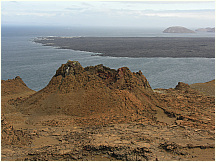 bartholomewisland22.jpg A volcanic cone on Bartholomew Island (Isla Bartolomé), Galapagos Islands, Ecuador |
|
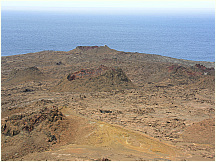 bartholomewisland23.jpg Volcanic cones and lava rocks, ash and cinders on Bartholomew Island (Isla Bartolomé), Galapagos Islands, Ecuador |
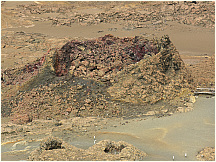 bartholomewisland24.jpg A volcanic cone on Bartholomew Island (Isla Bartolomé), Galapagos Islands, Ecuador |
|
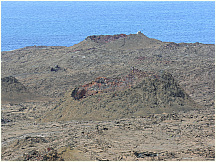 bartholomewisland25.jpg Volcanic cones and lava rocks, ash and cinders on Bartholomew Island (Isla Bartolomé), Galapagos Islands, Ecuador |
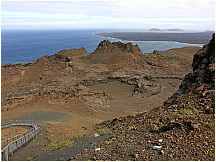 bartholomewisland26.jpg Volcanic cones, uneroded lava rocks and light weight cinders in piles on Bartholomew Island (Isla Bartolomé), Galapagos Islands, Ecuador |
The Marine Iguana, Blue-footed Booby and The Galápagos land iguana are signature animals of the Galápagos islands. Sea lions in the Galápagos are somewhat tame, but very curious. Though the first protective legislation for the Galápagos was enacted in 1934 and supplemented in 1936, it was not until the late 1950s that positive action was taken to control what was happening to the native flora and fauna. In 1955, the International Union for the Conservation of Nature organized a fact-finding mission to the Galápagos. Two years later, in 1957, UNESCO in cooperation with the government of Ecuador sent another expedition to study the conservation situation and choose a site for a research station.
In 1959, the centenary year of Charles Darwin's publication of The Origin of Species, the Ecuadorian government declared 97.5% of the archipelago's land area a national park, excepting areas already colonised. The Charles Darwin Foundation was founded the same year, with its international headquarters in Brussels. Its primary objectives are to ensure the conservation of unique Galápagos ecosystems and promote the scientific studies necessary to fulfill its conservation functions. Conservation work began with the establishment of the Charles Darwin Research Station on Santa Cruz Island in 1964. During the early years, conservation programs, such as eradication of introduced species and protection of native species, were carried out by station personnel. Currently, most resident scientists pursue conservation goals; most visiting scientists' work is oriented towards pure research.
When the national park was established, approximately 1,000 to 2,000 people called the islands their home. In 1972 a census was done in the archipelago and a population of 3,488 was recorded. By the 1980s, this number had dramatically risen to more than 15,000 people, and 2006 estimates place the population around 30,000 people. In 1986 the surrounding 70,000 square kilometres (43,496 sq mi.) of ocean was declared a marine reserve, second only in size to Australia's Great Barrier Reef. In 1990 the archipelago became a whale sanctuary. In 1978 UNESCO recognised the islands as a World Heritage Site, and in 1985 a Biosphere Reserve. This was later extended in December 2001 to include the marine reserve.
Noteworthy species include: Galápagos land iguana, Conolophus subcristatus Marine iguana, Amblyrhynchus cristatus (only iguana feeding from the sea) Galápagos tortoise (Galápagos Giant tortoise), Geochelone elephantopus, known as Galápago in Spanish, it gave the name to the islands. There are many notable creatures including the Blue-footed Booby (Sula nebouxii), Galápagos Green Turtle, thought to be a subspecies of the Pacific Green Turtle, (Chelonia mydas agassisi), Vampire Finch (Geospiza difficilis septentrionalis), or the Sharp Beaked Ground Finch. The sea cucumber, is the cause of continuing environmental battles with fishermen over quotas of this expensive Asian delicacy (Holothuria spp.) There are four endemic species of Mockingbirds, the first species Darwin noticed varying from island to island; 13 endemic species of buntings, popularly called Darwin's finches, Woodpecker Finch (Camarhynchus pallidus) Galápagos Penguin (Spheniscus mendiculus) present because of the frigid Antarctic Humboldt Current, Flightless Cormorant (Phalacrocorax harrisi), the Great Frigatebird and Magnificent Frigatebird, Galápagos Hawk (Buteo galapagoensis) Galápagos Sea lions (Zalophus californianus), closely related to the California Sea Lion, but smaller.
Environmental threats include: introduced plants and animals, such as feral goats, cats, and cattle, brought accidentally or willingly to the islands by humans. Quick to reproduce, these alien species decimate the habitats of native species. The native animals, lacking natural predators on the islands, are defenseless to introduced species and fall prey. Some of the most harmful introduced plants are the Guayaba or Guava Psidium guajava, avocado (Persea americana), cascarilla (Cinchona pubescens), balsa (Ochroma pyramidale), blackberry (Rubus glaucus), various citrus (orange, grapefruit, lemon), floripondio (Datura arborea), higuerilla (Ricinus communis) and the elephant grass (Pennisetum purpureum). These plants have invaded large areas and eliminated endemic species in the humid zones of San Cristobal, Floreana, Isabela and Santa Cruz. Also, these harmful plants are just a few of introduced species on the Galapagos Islands. There are over 700 introduced plant species today. There are only 500 native and endemic species. This difference is creating a major problem for the islands and the natural species that inhabit them.
Many species were introduced to the Galápagos by pirates. Thor Heyerdahl quotes documents that mention that the Viceroy of Peru, knowing that British pirates ate the goats that they themselves had released in the islands, ordered dogs to be freed there to eliminate the goats. Also, when colonization of Floreana by José de Villamil failed, he ordered that the goats, donkeys, cows, and other animals from the farms in Floreana be transferred to other islands for the purpose of later colonization. Non-native goats, pigs, dogs, rats, cats, mice, sheep, horses, donkeys, cows, poultry, ants, cockroaches, and some parasites inhabit the islands today. Dogs and cats attack the tame birds and destroy nests of birds, land tortoises, and marine turtles. They sometimes kill small Galápagos tortoises and iguanas.
Pigs are even more harmful, covering larger areas and destroying the nests of tortoises, turtles and iguanas. Pigs also knock down vegetation in their search for roots and insects. This problem abounds in Cerro Azul volcano and Isabela, and in Santiago pigs may be the cause of the disappearance of the land iguanas that were so abundant when Darwin visited. The black rat (Rattus rattus) attacks small Galápagos tortoises when they leave the nest, so that in Pinzón they stopped the reproduction for a period of more than 50 years; only adults were found on that island. Also, where the black rat is found, the endemic rat has disappeared. Cows and donkeys eat all the available vegetation and compete with native species for the scarce water.
In 1959, fishermen introduced one male and two female goats to Pinta island; by 1973 the National Park service estimated the population of goats to be over 30,000 individuals. Goats were also introduced to Marchena in 1967 and to Rabida in 1971. However a recent goat eradication program has cleared most of the goat population from Isabela. The fast growing poultry industry on the inhabited islands has been cause for concern from local conservationists, who fear that domestic birds could introduce disease into the endemic and wild bird populations. The Galápagos marine sanctuary is under threat from a host of illegal fishing activities, in addition to other problems of development. The most pressing threat to the Marine Reserve comes from local, mainland and foreign fishing targeting marine life illegally within the Reserve, such as sharks (hammerheads and other species) for their fins, and the harvest of sea cucumbers out of season. Development threatens both land and sea species. The growth of both the tourism industry and local populations fuelled by high birth rates and illegal immigration threaten the wildlife of the Archipelago. The recent grounding of the oil tanker Jessica and the subsequent oil spill brought this threat to world attention. Currently, the rapidly growing problems including tourism and a human population explosion are further destroying habitats.
(Adapted from: Galapagos. (2008). From Wikipedia, The Free Encyclopedia)
This page last updated January 2015
Visit http://www.TechnologySite.org for free
photos and lists of inventions and technology. Visit http://www.ClimateChangeFacts.info for unbiased
information about climate change. Visit http://www.ClimateCooling.org for eye-opening
biased information on global cooling and climate change and visit http://www.OceanAssoc.com for fisheries
and oceans consulting services.